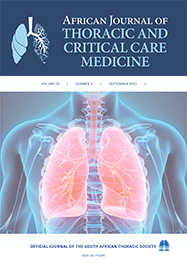Original research

Inhaler technique in patients attending an urban pulmonology practice
Abstract
Objective. To evaluate the use of inhaler therapy, primarily focusing on the source of the initial inhaler training and the effects of regular monitoring of inhaler use.
Methods. We conducted a prospective study of 200 adult patients using either a metered dose inhaler (MDI) or dry powder inhaler (DPI), attending a private pulmonology practice for the treatment of asthma, chronic obstructive pulmonary disease (COPD) or asthma-COPD overlap. Each patient was evaluated once, and assessed by the investigators irrespective of the patient’s background and inhaler technique training.
Results. The MDI and DPI techniques were found to be 45% and 79% adequate, respectively (p<0.001). Patients who had initial training in a specialist or pulmonology practice showed 100% adequacy. In stark contrast, inadequate technique was observed where initial MDI training was performed by family members, general practitioners, hospital staff, pharmacy staff and self (p<0.05). Similarly, inadequate technique was seen in the DPI group when taught by family members, general practitioners, hospital staff and pharmacy staff (p<0.001). The Accuhaler was used by 59% of the patients using a DPI; 41% used the Turbuhaler. The percentage of inadequate inhaler technique in the Accuhaler was 28%, while the percentage of inadequate inhaler use in the urbuhaler group was lower at 10% (p<0.001).
Conclusion. In an urban private practice environment, the adequacy of inhaler technique was shown to be suboptimal. DPI technique was found to be superior to MDI technique, and the Turbuhaler was employed more adequately than the Accuhaler. There was no correlation between the duration of inhaler use and technique, but patients initially taught by non-pulmonology specialists and pulmonologists showed superior technique to that of other groups, i.e. patients taught by family members, general practitioners and hospital staff.
Authors' affiliations
J A Vanderwagen, Morningside Mediclinic, Johannesburg
C Smith, Morningside Mediclinic, Johannesburg
Full Text:
Cite this article
Article History
Date published: 2017-03-29
Article Views
Full text views: 454
Refbacks
- There are currently no refbacks.
African Journal of Thoracic and Critical Care Medicine| Online ISSN: 2617-0205
This journal is protected by a Creative Commons Attribution - NonCommercial Works License (CC BY-NC 4.0) | Read our privacy policy.
Our Journals: South African Medical Journal | African Journal of Health Professions Education | South African Journal of Bioethics and Law | South African Journal of Child Health | Southern African Journal of Critical Care | African Journal of Thoracic and Critical Care Medicine| South African Journal of Obstetrics and Gynaecology |



.jpg)